Bay of Islands: Day Two – At the crack-of-dawn on the second day of the National Geographic Orion’s inaugural sailing, she took her 102-guests and me into the Bay of Islands.
The water was calm as the sun slowly rose from the east to reveal a sheltered yet scenic bay off the small town of Russell and across the water I could see the historic site of Waitangi.
I joined everyone on board for a quick breakfast at the outdoor café, you must try fresh pastries that are made fresh daily – before heading to the ship’s Zodiacs.
Expert expedition staff on board and local guides took us on a historic water tour of the area.
Captain James Cook was the first European to visit this area in 1769. As well as naming the location Waitangi, he was also the first to interact with the local Maori people.
Whalers and sealers came next towards the end of the 18th century, and shortly afterwards the first Missionaries. But it wasn’t until 1840 that an official Treaty of Waitangi was signed between Europe and the Maori leaders to make this place what it is today.
Our guides gave us a full and rich rundown of this history, and what it means to Maori and Pakeha (New Zealanders of European descent) today, as well as an insight into the lives of the Maori, and their culture. Several large waka (canoes) were on display and made for spectacular photography.
I, along with other guests, wandered around the beautiful treaty grounds before watching a cultural performance and experienced a traditional welcoming onto the Marae.
Afterwards we were able to talk with and have photographs with the performers, before slowly walking back through the grounds on our own, or with the Photo Instructors or other Expedition Staff. They were able to point out flora of interest and some of the local wildlife, including tui, New Zealand fantail, variable and South Island oystercatchers and New Zealand dotterel.
We headed back to the National Geographic Orion for lunch in the sunshine, before boarding the Zodiacs again for time ashore in the quaint little town of Russell.
Once described as a ‘Hell-hole of the Pacific’, the town was renown for whalers and sealers. Today it is a picturesque town nestled amongst the forest covered hills, with bustling cafes and bars, small boutique shops, and tree lined narrow streets. We joined naturalists Tom, Mike, and Darrin for a walk to the top of Flagstaff Hill.
Other naturalists from the expedition team Brent and Richard led a nature walk spotting birds and enjoying the rich flora. National Geographic Photographers Amy and Matt led a photographic walk around the town. With sunshine and warm temperatures, it was not hard to enjoy our time ashore, but before long it was time to head back to the ship.
As the anchor was raised, the last of the Zodiacs were hoisted onboard, and we sailed out of the Bay of Islands to be greeted by a pod of bottlenose dolphins.
The animals ‘played’ with the ship, riding the bow wave created by the bulbous bow, and we had great views of these large dolphins from the front of the ship. They escorted us for a little while, as we headed northwards along the eastern coast of Northland.
Otherwise, click here to read Day One for details on the ship’s inauguration.
WORDS: Jeremy Lindblad








